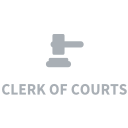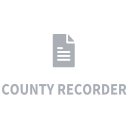History of Clerk of Courts
The office of the Clerk of the Court of Common Pleas traces its origin to the medieval cleric. They maintained the records, were responsible for correspondence and had various powers to issue writs or other processes ordered by the Court. The cleric was generally one of the few educated persons in the community.
In creating a state judicial system, the 1802 Ohio Constitution provided for the appointment of a Clerk of Courts for each county. The judges of the Common Pleas Court made the appointments for a seven year term.
Under the 1851 Constitution the office became elective for a three-year term which was extended to four years in 1936.
The official title is Clerk of the Court of Common Pleas, but most often the office holder is referred to as the Clerk of Courts.
Many prominent Ohioans have served as Clerk of the Court of Common Pleas. For example, William Henry Harrison, ninth President of the United States, was a Clerk of Courts when he was elected President in 1840.
The duties mandated by the statutes of the Ohio Revised Code have grown tremendously over the years. The responsibilities of the Clerk of Court of Common Pleas are set forth in over 250 sections of the Ohio Revised Code.
Core of the Court
The Clerk of Courts office, as the "core of the Court", plays a vital role in serving the interest of justice. This includes filing, docketing, indexing and preserving all court pleadings for civil, felony criminal and domestic relations cases. The Clerk of Courts must also follow procedure required by law and issue writs to carry out Court orders. Some of these writs include summons, subpoenas, warrants to arrest and to convey to penal institutions, and signing the death warrant in capital cases.
In a number of counties, the duties of a Municipal Court Clerk have been assigned to the Clerk of the Court of Common Pleas.
In addition to processing all Court paperwork, the Clerk of Courts must preserve all of these records for use by future generations. All of the 88 Counties have computer systems to streamline this process. Archival quality retention must be used to permanently preserve the Court records. One of the largest revenue sources to the State of Ohio is the 88 Clerks of the Court of Common Pleas. Annually the fees and taxes disbursed to the State by the Clerk of Courts' legal and title offices exceeds 1.5. billion dollars.
The Automobile and Watercraft Title Division of the Clerk of Court of Common Pleas is linked throughout the State of Ohio by a sophisticated computer network. This Automated Title Processing System (ATPS) provides fast, efficient issuance of approximately 8 million Ohio Titles annually. Through cross-county titling, an Ohio resident is able to obtain a title in any county in the State of Ohio. A certificate of title is documented proof of ownership. In some counties the Clerk of Courts has located a Title Office with or near the State License Bureau and Highway Patrol Driver Examination Station to provide convenient, one-stop service.
In addition to collecting billions of dollars in sales and use taxes for the purchase of automobiles, the Clerk of Courts is responsible for collecting all revenue relating to court cost. bonds, fines and forfeitures. Clerks of the Court of Common Pleas are responsible for receiving and disbursing millions of other dollars which are directed to various accounts of the county and state. In certain counties these revenues total over 100 million dollars. The Clerk may invest undisbursed funds which generate interest revenue for the county general fund, and in may counties is significant source of revenue.
Ohio's Clerks of the Court of Common Pleas also:
- Accept Bonds
- Call Juries
- Administer Oaths
- File State Tax Liens
- File Judgment Liens
And serve as a member of the following:
- County Data Processing Board
- County Records Commission
- County Microfilm Board
- County Courthouse Construction and Improvement Committee
- County Courthouse Security Committee
| Attachment | Size |
|---|---|
| Clerk of Courts Brochure | 3.72 MB |
History of Clerk of Courts
The office of the Clerk of the Court of Common Pleas traces its origin to the medieval cleric. They maintained the records, were responsible for correspondence and had various powers to issue writs or other processes ordered by the Court. The cleric was generally one of the few educated persons in the community.
In creating a state judicial system, the 1802 Ohio Constitution provided for the appointment of a Clerk of Courts for each county. The judges of the Common Pleas Court made the appointments for a seven year term.
Under the 1851 Constitution the office became elective for a three-year term which was extended to four years in 1936.
The official title is Clerk of the Court of Common Pleas, but most often the office holder is referred to as the Clerk of Courts.
Many prominent Ohioans have served as Clerk of the Court of Common Pleas. For example, William Henry Harrison, ninth President of the United States, was a Clerk of Courts when he was elected President in 1840.
The duties mandated by the statutes of the Ohio Revised Code have grown tremendously over the years. The responsibilities of the Clerk of Court of Common Pleas are set forth in over 250 sections of the Ohio Revised Code.
Core of the Court
The Clerk of Courts office, as the "core of the Court", plays a vital role in serving the interest of justice. This includes filing, docketing, indexing and preserving all court pleadings for civil, felony criminal and domestic relations cases. The Clerk of Courts must also follow procedure required by law and issue writs to carry out Court orders. Some of these writs include summons, subpoenas, warrants to arrest and to convey to penal institutions, and signing the death warrant in capital cases.
In a number of counties, the duties of a Municipal Court Clerk have been assigned to the Clerk of the Court of Common Pleas.
In addition to processing all Court paperwork, the Clerk of Courts must preserve all of these records for use by future generations. All of the 88 Counties have computer systems to streamline this process. Archival quality retention must be used to permanently preserve the Court records. One of the largest revenue sources to the State of Ohio is the 88 Clerks of the Court of Common Pleas. Annually the fees and taxes disbursed to the State by the Clerk of Courts' legal and title offices exceeds 1.5. billion dollars.
The Automobile and Watercraft Title Division of the Clerk of Court of Common Pleas is linked throughout the State of Ohio by a sophisticated computer network. This Automated Title Processing System (ATPS) provides fast, efficient issuance of approximately 8 million Ohio Titles annually. Through cross-county titling, an Ohio resident is able to obtain a title in any county in the State of Ohio. A certificate of title is documented proof of ownership. In some counties the Clerk of Courts has located a Title Office with or near the State License Bureau and Highway Patrol Driver Examination Station to provide convenient, one-stop service.
In addition to collecting billions of dollars in sales and use taxes for the purchase of automobiles, the Clerk of Courts is responsible for collecting all revenue relating to court cost. bonds, fines and forfeitures. Clerks of the Court of Common Pleas are responsible for receiving and disbursing millions of other dollars which are directed to various accounts of the county and state. In certain counties these revenues total over 100 million dollars. The Clerk may invest undisbursed funds which generate interest revenue for the county general fund, and in may counties is significant source of revenue.
Ohio's Clerks of the Court of Common Pleas also:
- Accept Bonds
- Call Juries
- Administer Oaths
- File State Tax Liens
- File Judgment Liens
And serve as a member of the following:
- County Data Processing Board
- County Records Commission
- County Microfilm Board
- County Courthouse Construction and Improvement Committee
- County Courthouse Security Committee
| Attachment | Size |
|---|---|
| Clerk of Courts Brochure | 3.72 MB |








